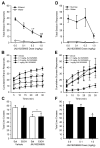Effects of mGlu1-receptor blockade on ethanol self-administration in inbred alcohol-preferring rats
- PMID: 18164577
- PMCID: PMC2350187
- DOI: 10.1016/j.alcohol.2007.11.001
Effects of mGlu1-receptor blockade on ethanol self-administration in inbred alcohol-preferring rats
Abstract
The Group I family of metabotropic glutamate receptors includes subtype 1 (mGlu1) and subtype 5 (mGlu5) receptors. This family of receptors has generated interest as potential targets for different areas of therapeutic development, including intervention for alcohol and drug abuse. Most of this interest is driven by findings showing involvement of mGlu5 receptors in the regulation of drug self-administration; however, studies examining the role of mGlu1 receptors in drug self-administration are limited. The purpose of this work was to examine the role of mGlu1-receptor antagonism in the maintenance of ethanol self-administration and the self-administration of an alternate nondrug reward, sucrose. Male alcohol-preferring inbred rats were trained to self-administer ethanol (15% vol/vol) versus water on a concurrent schedule of reinforcement, and the effect of the mGlu1-receptor antagonist JNJ16259685 (0.1-1.0mg/kg intraperitoneal [IP]) was evaluated on self-administration. The rats were then trained to self-administer sucrose (0.4% wt/vol) versus water, and the same dose range of JNJ16259685 was tested. Locomotor activity was tested in a separate assessment to evaluate potential nonspecific motor effects of the antagonist. Ethanol self-administration was dose dependently reduced by JNJ16259685. This reduction was likely due to a motor impairment as the lowest effective dose (0.1mg/kg) significantly reduced locomotor behavior. Sucrose self-administration was reduced by the highest JNJ16259685 dose (1.0mg/kg), and this reduction was also likely due to a motor impairment. Interestingly, ethanol self-administration was more sensitive to mGlu1-receptor antagonism than sucrose self-administration as lower JNJ16259685 doses reduced ethanol-reinforced responding and motor behavior. Together, these results suggest that mGlu1 receptors do not play a specific role in modulating ethanol self-administration or the self-administration of an alternate nondrug reward (i.e., sucrose).
Figures

References
-
- Abe T, Sugihara H, Nawa H, Shigemoto R, Mizuno N, Nakanishi S. Molecular characterization of a novel metabotropic glutamate receptor mGluR5 coupled to inositol phosphate/Ca2+ signal transduction. J Biol Chem. 1992;267:13361–13368. - PubMed
-
- Backstrom P, Bachteler D, Koch S, Hyytia P, Spanagel R. mGluR5 antagonist MPEP reduces ethanol-seeking and relapse behavior. Neuropsychopharmacology. 2004;29:921–928. - PubMed
-
- Backstrom P, Hyytia P. Ionotropic and metabotropic glutamate receptor antagonism attenuates cue-induced cocaine seeking. Neuropsychopharmacology. 2006;31:778–786. - PubMed
-
- Bell RL, Kimpel MW, Rodd ZA, Strother WN, Bai F, Peper CL, Mayfield RD, Lumeng L, Crabb DW, McBride WJ, Witzmann FA. Protein expression changes in the nucleus accumbens and amygdala of inbred alcohol-preferring rats given either continuous or scheduled access to ethanol. Alcohol. 2006;40:3–17. - PubMed
Publication types
MeSH terms
Substances
Grants and funding
LinkOut - more resources
Full Text Sources

